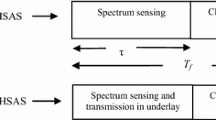Abstract
In this paper a novel cognitive radio system model is proposed in which secondary user transmitter (SU-Tx) operates under two modes underlay and overlay, based on the channel sensing information it receives. This is an effort to maximize transmission data rate based on the threshold which decides the mode of operation. In this paper, the resources are utilized efficiently by making them operate in both the modes. It provides the optimal power allocation to the CR user in a way that it should not provide interference to its neighbouring users, specifically the most prioritized primary/licensed users. The performance of each mode is analyzed with attainable ergodic and outage capacity.





Similar content being viewed by others
References
Federal Communications Commission. (2002). Spectrum policy task force. Rep. ET Docket no. 02-135.
Haykin, S. (2005). Cognitive radio: Brain-empowered wireless communications. IEEE Journal on Selected Areas in Communication, 23(2), 201–220.
Akyildiz, G., Lee, W. Y., Vuran, M. C., & Mohanty, S. (2006). Next generation/dynamic spectrum access/cognitive radio wireless networks: A survey. Computer Networks, 50, 2127–2159.
Ma, J., Li, G. Y., & Juang, B. H. (2009). Signal processing in cognitive radio. Proceedings of the IEEE, 97(5), 805–823.
Axell, E., Leus, G., Larsson, E. G., & Poor, H. V. (2012). Spectrum sensing for cognitive radio: State of the art and recent advances. IEEE Signal Processing Magazine, 29(3), 101–116.
Moessner, K., Harada, H., et al. (2011). Spectrum sensing for cognitive radio systems: Technical aspects and standardization activities of the IEEE P1900.6 working group. IEEE Wireless Communications, 18, 3–37.
Yucek, T., & Arslan, H. (2009). A survey of spectrum sensing algorithms for cognitive radio applications. IEEE Communications Surveys & Tutorials, 11(1), 116–130.
Ghasemi, A., & Sousa, E. S. (2008). Spectrum sensing in cognitive radio networks: Requirements, challenges and design trade-offs. IEEE Communications Magazine, 46(4), 32–39.
Ghasemi, A., & Sousa, E. S. (2007). Fundamental limits of spectrum-sharing in fading environments. IEEE Transactions on Wireless Communications, 6(2), 649–658.
Sun, C., Alemseged, Y. D., & Tran, H. N. (2010). Transmit power control for cognitive radio over a Rayleigh fading channel. IEEE Transactions on Vehicular Technology, 59(4), 1847–1857.
Bansal, G., Hossain, M. J., & Bhargava, V. K. (2011). Adaptive power loading for OFDM-based cognitive radio systems with statistical interference constraint. IEEE Transactions on Wireless Communications, 10(9), 2786–2791.
Bansal, G., Hossain, M. J., & Bhargava, V. K. (2008). Optimal and suboptimal power allocation schemes for OFDM-based cognitive radio systems. IEEE Transactions on Wireless Communications, 7(11), 4710–4718.
Stotas, S., & Nallanathan, A. (2011). Enhancing the capacity of spectrum sharing cognitive radio networks. IEEE Transactions on Vehicular Technology, 60(8), 3768–3779.
Goldsmith, A. (2005). Wireless communications. Stanford University, Cambridge University Press.
Wang, Y., Ren, P., Gao, F., & Su, Z. (2014). A hybrid underlay/overlay transmission mode for cognitive radio networks with statistical quality-of-service provisioning. IEEE Transactions on Wireless Communications, 13(3), 1482–1498.
Musavian, L., & Äıssa, S. (2007). Ergodic and outage capacities of spectrum-sharing systems in fading channels. In Global Telecommunications Conference, GLOBECOM. (pp. 3327–3331). IEEE.
Musavian, L., & Lambotharan, S. (2011). Power allocation under service-outage constraints for spectrum-sharing cognitive radio networks. In First UK-India international workshop on cognitive wireless systems (pp. 1–4). IEEE.
Palomar, D. P., & Chiang, M. (2006). A tutorial on decomposition methods for network utility maximization. IEEE Journal on Selected Areas in Communications, 24(8), 1439–1451.
Boyd, S., & Vandenberghe, L. (2004). Convex optimization. Cambridge: Cambridge University Press.
Boyd, S., Xiao, L., & Mutapcic, A. (2003). Subgradient methods. Notes for EE392o, Stanford University.
Author information
Authors and Affiliations
Corresponding author
Rights and permissions
About this article
Cite this article
Gupta, J., Karwal, V. & Dwivedi, V.K. Joint Overlay-Underlay Optimal Power Allocation in Cognitive Radio. Wireless Pers Commun 83, 2267–2278 (2015). https://doi.org/10.1007/s11277-015-2516-x
Published:
Issue Date:
DOI: https://doi.org/10.1007/s11277-015-2516-x




